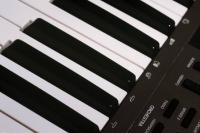|
|
Digital Recording, Music Technology and how
we use the DAW and MIDI ...
|
||||||||||||
|
|
|||||||||||||
|
An Introduction to Digital Recording, Digital Music
Technology, using a Digital Audio Workstation (DAW) and how we use MIDI to
produce music tracks in the Studio Today
all professional audio recording is done digitally using a DAW and Digital
Music Technology. Backing tracks can also be (and often are) produced in the
studio using hardware and/or software synthesisers and samplers controlled by
MIDI. There
are two aspects to using a DAW. One is where the DAW is simply like a giant
multi-track tape recorder with many sophisticated processors and effects.
Typically, we would import or record a backing track on one track of the DAW
and then record the vocal (or other instrument) on
another track. We often re-record the vocal or part of it another couple of
times on different tracks of the DAW and then seamlessly mix and match the
best parts of each vocal track to get the optimum result before mixing the
vocal with the backing track and exporting it ready for a CD or in a form to
enable it to be stored on a playback device such as a phone – or perhaps in a
form to attach to an email. The
other aspect of the DAW is to produce music from its built-in synthesisers
(or external synthesiser) using MIDI tracks. Nowadays, synthesisers seldom “synthesise”
music electronically but play multiple samples of real instruments which have
been recorded digitally and stored in the synth’s instrument sound banks. Many
think that putting together musical arrangements using MIDI is a black art –
but although initially MIDI can be confusing, using MIDI and the DAW to
produce music tracks becomes simple with practice - but only if you know what
you are doing. The problem for beginners is they often don’t know where to start
and don’t even know what questions to ask or who to ask to get started.
Textbooks are often confusing and hard work to learn from although they are very
useful for reference later. These areas are some of the issues this teaching
module has been designed to address. There are several ways of entering the
MIDI music information into the DAW, each having its own benefits and
limitations. Beginners
usually have no idea how to combine the synthesiser music they produce on the
DAW with their vocals or “real
instrument” they record and often do not know which kind of microphone to
use or even how to use it. Mixing everything together to produce an audio
file to burn on to a CD seems like another black art to start with but it
soon becomes clear – if you are taught the right things in the right order in
the right way. The many aspects of using all this Music Technology can be
very daunting at first and all these areas are covered. We start assuming you
know nothing – always the safest place to start – and proceed in a structured
way to build up your knowledge and experience at your pace to enable you to achieve what you
want to achieve. All these areas are covered in detail. Below
are just some of the MIDI topics covered …
|
||||||||||||
|
| Home Page | Guitar / Base Tuition | A Recording Studio | How to use MIDI | Musical
Arrangements | A 3-piece Band | More Info on Pennyland Music | Contact Details | How to Find Us | |
|||||||||||||

